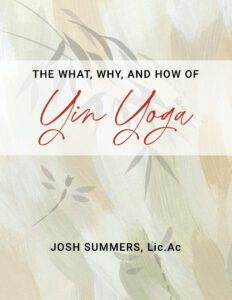View Previous Lesson View Next Lesson
In this series of 4 lessons, I explore the experience and function of stillness in meditation. I differentiate between external stillness (that is, stillness of the body) and internal stillness (experiences of deep quietude and calm). I also consider how the experience of stillness contributes to the development of wisdom, and how Yin Meditation offers three unconventional ways of developing states of meditative stillness.
You can listen to all four lessons in this module here, and then download the Stillness in Meditation Worksheet below and begin practicing:
Or view each lesson individually:
- Exploring Stillness: In this lesson, I talk about the meditative experience of stillness in a few different ways. I consider the difference between what I call “external stillness” – that is stillness of your body during meditation, and “internal stillness” – that is the experience of quietude and calm. And I’ll be talking about these experiences in terms of what they are felt like and the particular function that they serve in the development of your meditation.
- Natural Absorption: In this lesson, I look at the first of three ways that Yin Meditation develops stillness. I discuss how letting yourself get naturally absorbed in things that come up in your practice can lead to effortless stillness. In Yin Meditation, when you dial back any effort to try and control your mind, you’re giving your mind space to explore things that it finds naturally engaging. For example, while relaxing and being receptive to your experience in meditation, you might find that you start to think about about a dynamic at work, or an unfinished project at home, or a disagreement with someone, or a holiday you’d like to take. In allowing your mind to get absorbed into these kinds of themes and topics, certain qualities of focus and calm – often listed in meditation texts – start to develop.
- Relaxing Within the Hindrances: Often in meditation, the obstacles to states of stillness and calm are referred to as the Hindrances. They are the mind-states of Desire, Dislike, Restlessness, Sleepiness, and Doubt. In this lesson, I look at the Hindrances from both Yang and Yin angles and offer ways to work more skillfully with them. In contrast to more active and Yang ways of working with the hindrances, I’ve found it incredibly fruitful to adopt a more Yin approach. Rather than deploying any prescribed technique or strategy for dealing with them, I’ve found that bringing a relaxed, receptive, tolerant, and curious energy towards the hindrances is a really good first step. These qualities reframe the energy that my mind tends to have in approaching each hindrance. I’m a bit softer and friendlier, encouraging a broader exploration of their energy.
- The Door of Sleepiness: Sleepiness is often viewed as sign of failure in meditation. But for me, and many that I’ve spoken to and worked with, allowing sleepiness to be, ie. Letting it go on, is the most effective strategy for working with and also a counterintuitive way to enter states of stillness and calm. This lesson explores the doorway into stillness that Sleepiness provides.
Downloads
Instructions: Practice 2 sessions of at least 20 minutes each, and journal 15 minutes after each session.
Mark this module as favorite / complete:
[lms_favorite] [lms_complete]

